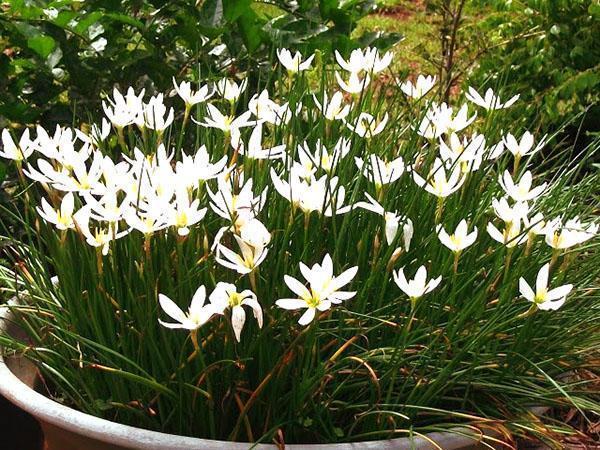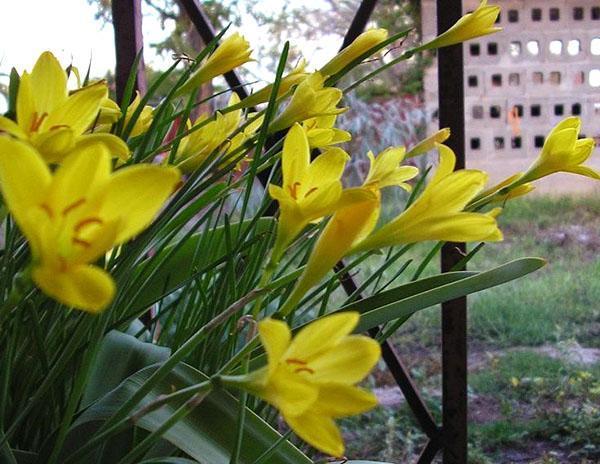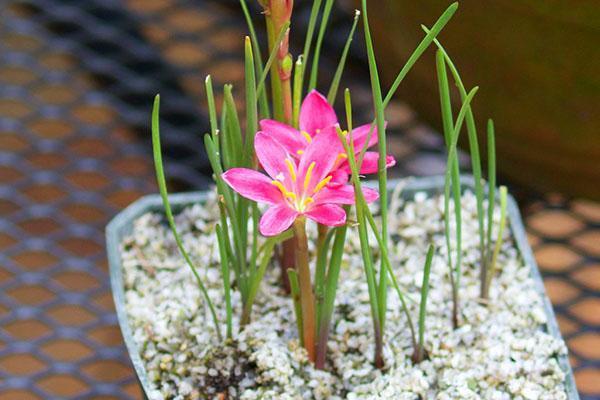Planting and caring for zephyranthes at home
 In warm areas of the American continent, perennial bulbous marshmallows are unpretentious, beautifully flowering plants for flower beds, decorations alpine slides and green lawns. But in central Russia zephyranthes, home care sand which is as simple as in the open field, is a pot culture found on city windowsills.
In warm areas of the American continent, perennial bulbous marshmallows are unpretentious, beautifully flowering plants for flower beds, decorations alpine slides and green lawns. But in central Russia zephyranthes, home care sand which is as simple as in the open field, is a pot culture found on city windowsills.
Description and features of the indoor flower zephyranthes
To distinguish zephyranthes from other popular bulbous plants, help:
- elongated leaves extending from the neck of the bulb;
- erect or lodging peduncles about 25 cm long;
- single flowers of various colors, similar in shape to those better known to gardeners crocuses or sparaxis.
The diameter of the corolla with tubular bracts is 7–9 cm, and the color of the petals and the core depends on the variety and variety of zephyranthes. Florists consider the almost lightning-fast development and appearance of peduncles with buds to be a unique ability of the plant. But after the end of flowering, the developing leaves most often die off, and the marshmallow falls into "sleep" for several months.
These cultural features must be taken into account when caring for zephyranthes at home.
Zephyranthes flower care during vegetation, flowering and dormancy

With proper care of the marshmallow, planting in a well-lit area will ensure rapid growth of mothers and the emergence of new bulbs.
In addition to the bright sun, during the growing season, the bulbous culture requires:
- air warmed up to 20-25 ° C;
- regular deposit fertilizers, at least once every 10-14 days;
- getting warm, settled moisture.
Watering is carried out as the top 2-centimeter layer of the substrate dries up. If there is more moisture than the plant requires, its stagnation and decay of the branched system of roots and the bottom of the bulb cannot be avoided.
In summer, when the air is dry and hot, spraying greenery is an effective addition to watering. This home care measure for marshmallows, as shown in the photo, helps keep foliage and flowers fresh even outdoors.
 By September, Zephyranthes begins to prepare for "hibernation". In most species of this bulbous culture, the dormant state lasts for several months. The impetus for awakening in natural conditions is seasonal climate change. At home, regulate the course of life, changes in the care of the zephyranthes flower and temperature fluctuations.
By September, Zephyranthes begins to prepare for "hibernation". In most species of this bulbous culture, the dormant state lasts for several months. The impetus for awakening in natural conditions is seasonal climate change. At home, regulate the course of life, changes in the care of the zephyranthes flower and temperature fluctuations.
When the leaves wither and fall on the plant, this means that it is time to transfer the zephyranthes to a cool room, where it will be dry and dark. The optimum temperature can fluctuate between 5-14 ° C, but if it drops below, there is a risk of freezing the bulbs.
During the dormant period, the plants do not need full-scale watering, they are not fed. But to avoid drying out the bulbs, the soil is sometimes carefully moistened with standing water.
With the onset of spring, the plant's life processes are activated, the first green foliage appears, and after it the buds.At this time, the pot is transferred to the light and the feeding and watering, interrupted for the winter, begin. Zephyranthes care is back on track.
 In some species, the leaves do not fall for the winter. Therefore, they are not removed in the dark, but they try to keep them at low temperatures, slightly limiting watering.
In some species, the leaves do not fall for the winter. Therefore, they are not removed in the dark, but they try to keep them at low temperatures, slightly limiting watering.
Planting and caring for zephyranthes during flower reproduction
Every year, several small daughter bulbs are formed around the adult zephyranthes bulbs, which are easy to separate and give life to new plants.
 If planting and caring for the zephyranthes were carried out correctly, young bulbs quickly lay the rudiments of peduncles and open the buds a year after separation from the mother plant.
If planting and caring for the zephyranthes were carried out correctly, young bulbs quickly lay the rudiments of peduncles and open the buds a year after separation from the mother plant.
The easiest way to collect small bulbs is in the fall, when transplanting. For planting, take wide boxes or pots, lay a drainage layer on their bottom, and pour a mixture of equal shares on top of it:
- humus;
- sand;
- peat;
- turf land.
It is good if the soil was sterilized before planting the zephyranthes and caring for the bulbous plant. This will exclude infection of the bulbs with fungi or damage to the rhizomes by pests.
Zephyranthes are relatively small plants, so they look much more spectacular in group plantings, where there are from 8 to 15 bulbs nearby. When planting in the ground, be sure to pay attention to the fact that the thin, graceful neck of the bulb remains above the surface of the substrate.
 Similarly, planting crops in the open field. If the marshmallow plants are well-groomed, as in the photo, at home they can be pollinated and give seeds. From the moment of artificial pollination to the collection of sowing material, it takes about 60 days. Sowing is carried out in the same season, otherwise the germination of seeds drops sharply.
Similarly, planting crops in the open field. If the marshmallow plants are well-groomed, as in the photo, at home they can be pollinated and give seeds. From the moment of artificial pollination to the collection of sowing material, it takes about 60 days. Sowing is carried out in the same season, otherwise the germination of seeds drops sharply.
 Seeds are spread on the surface of a loose ready-made substrate at a distance of 2-3 cm from each other, lightly sprinkled with soil and placed in partial shade. At a temperature of about 22–24 ° C in a greenhouse, the seedling boxes last up to 4 weeks. In most species, after this time, the first young shoots appear. Zephyranthes caring bears good fruit. Flower specimens grown from seeds open their buds for the first time in the third year of life.
Seeds are spread on the surface of a loose ready-made substrate at a distance of 2-3 cm from each other, lightly sprinkled with soil and placed in partial shade. At a temperature of about 22–24 ° C in a greenhouse, the seedling boxes last up to 4 weeks. In most species, after this time, the first young shoots appear. Zephyranthes caring bears good fruit. Flower specimens grown from seeds open their buds for the first time in the third year of life.